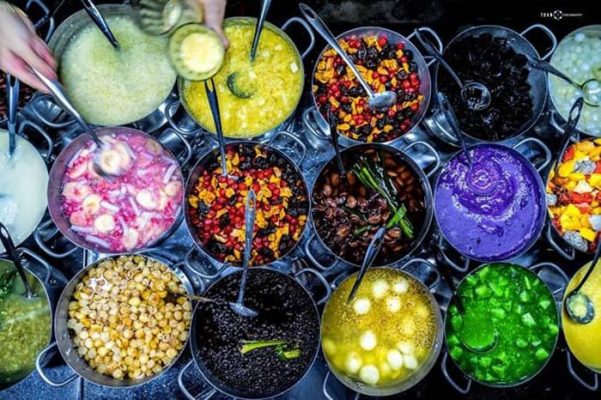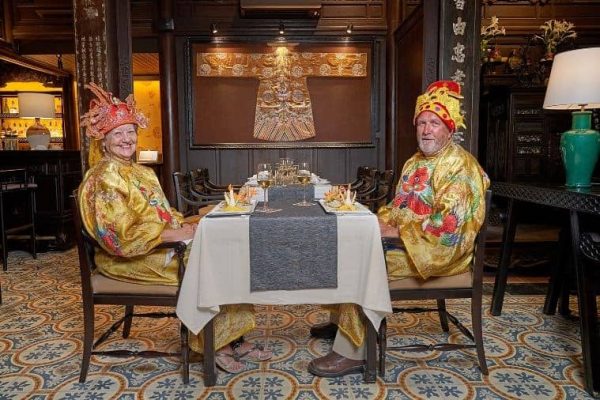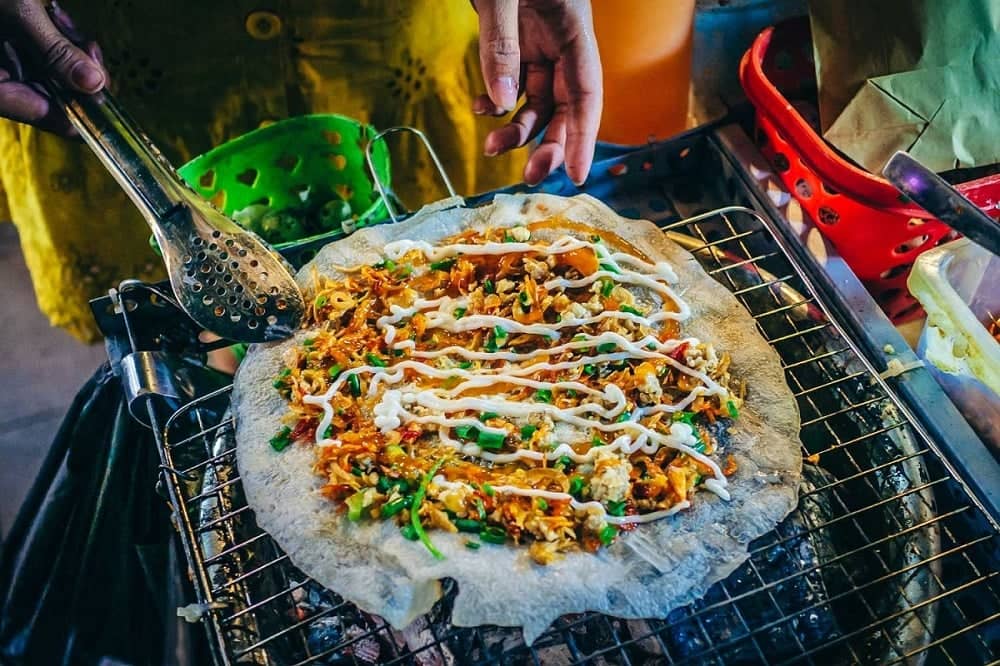
Hue Cuisine
Hue cuisine is known for its elegance and exquisite flavors, as well as its simplicity and sophistication, which are always highly regarded. Especially, the renowned royal cuisine in Hue is famous not only for its preparation but also for its intricate presentation, delicately adorned dishes resembling an art form meticulously crafted. With its pure, refined flavors, it is also famous for its health benefits, adding a distinctive touch not commonly found in every region.
I. Distinctive Features of Hue Cuisine
1. Sophistication and Refinement
Hue cuisine is more than just food; it’s an art form. From preparation to presentation, every dish reflects meticulous care and sophistication. As the pinnacle of Vietnamese imperial cuisine, Hue’s dishes often involve intricate cooking techniques and elaborate plating, exemplified by specialties like nem cong (peacock rolls), cha phuong (phoenix patties), and five-colored cakes.
2. Diverse Flavors
Hue cuisine achieves a perfect balance of spicy, salty, sweet, sour, and bitter flavors. The dishes are typically seasoned boldly, suitable for the central region’s climate. Hue is also known for its unique use of spices, such as fish sauce, chili, garlic, and various herbs, creating a distinctive taste that sets it apart from other regions.
3. Reflection of Imperial and Folk Culture
While Hue’s imperial cuisine embodies elegance and luxury, with dishes once reserved for royalty, its folk cuisine showcases the simplicity yet richness of the local lifestyle. Popular dishes like banh beo (steamed rice cakes), banh loc (tapioca dumplings), banh nam (flat rice dumplings), and com hen (clam rice) exemplify the perfect harmony of aesthetics and accessibility in Hue’s culinary tradition.
II. Why International Tourists Should Explore Hue Cuisine
1. Experience Culture Through Food
Every dish in Hue tells a story, reflecting the history and culture of this ancient capital. By enjoying a traditional Hue meal, visitors not only savor unique flavors but also gain insight into the lifestyle, customs, and soul of the local people.
2. Discover the Distinctiveness Compared to Other Regions
Hue cuisine stands out with its distinctive style, markedly different from other parts of Vietnam. While northern cuisine is known for its subtlety and southern cuisine leans towards sweetness, central cuisine—especially Hue’s—is characterized by its bold, spicy flavors. This uniqueness offers international tourists a rich and unforgettable culinary journey.
3. Unique Dining Ambience
Visitors to Hue can enjoy its cuisine in spaces steeped in history, from restaurants that recreate imperial settings to quaint street-side eateries along the Perfume River. Each setting offers a mix of romance and intimacy, leaving tourists with unforgettable memories.
III. Hue’s Iconic Cuisine
Hue is not only famous for its poetic scenery but also regarded as the cradle of a sophisticated and diverse culinary tradition. From royal dishes to rustic street foods, Hue’s cuisine encapsulates cultural essence and unique creativity, leaving an unforgettable impression on visitors.
1. Hue Royal Cuisine
The royal cuisine of Hue reflects meticulousness and elegance in preparation, presentation, and cultural significance. These dishes, once served to kings and the royal family, embody the grandeur and artistry of Hue’s culinary heritage.
Nem Cong Cha Phuong (Peacock Spring Rolls and Phoenix Meatloaf)

Nem Cong Cha Phuong was often served in the royal court in ancient times.
Nem Cong Cha Phuong is a highlight of traditional royal banquets. Nem Cong is made from finely seasoned pork or shrimp, carefully molded to resemble a peacock, while Cha Phuong is crafted into a phoenix shape. These dishes are not only culinary delights but also artistic masterpieces, showcasing the chef’s exceptional skill and creativity.
Banh Phu The (Husband and Wife Cake)

Banh Phu The often appears in traditional weddings.
This delicacy symbolizes happiness and fidelity in marriage. Made from tapioca flour, filled with mung bean and sweetened with rock sugar, the cakes are wrapped in pandan leaves, giving them a delicate and elegant appearance. Often seen at traditional weddings, Banh Phu The represents wishes for a harmonious and prosperous married life.
Do not miss: Central Vietnam Wonders Tour
2. Hue Street Food
Alongside the grandeur of royal dishes, Hue street food scene stands out with its simple yet exquisite offerings. These dishes capture the soul of Hue’s streets and are beloved by both locals and visitors.
Bun Bo Hue (Hue Beef Noodle Soup)

Bun Bo Hue is the most famous and favorite dish of Hue.
No discussion of Hue cuisine is complete without mentioning Bun Bo Hue—the “soul” of this imperial city. With a broth crafted from beef bones, shrimp paste, and lemongrass, the dish delivers a rich and aromatic flavor. The bowl is beautifully arranged with tender beef slices, flavorful crab sausage, and a hint of chili paste, accompanied by fresh herbs for a balanced and satisfying experience.
Banh Beo, Banh Nam, Banh Loc (Hue’s Trio of Savory Cakes)
These three signature dishes epitomize Hue’s philosophy of “slow dining.”
- Banh Beo (Steamed Rice Cake): Made from rice flour, Banh Beo is served in small bowls with a topping of dried shrimp, crispy shallots, and sweet fish sauce.
- Banh Nam (Flat Rice Dumpling): Soft and flavorful, Banh Nam is wrapped in banana leaves and filled with finely ground shrimp, served with sweet and tangy dipping sauce.
- Banh Loc (Tapioca Dumpling): Transparent and chewy, this dumpling is filled with seasoned shrimp and pork, offering a delightful rustic flavor.
Che Hue (Hue Sweet Soups)

Hue is famous for its elaborate and delicious desserts.
Hue is renowned for its wide variety of sweet soups, from luxurious royal desserts to humble street treats. The most unique is Che Bot Loc Heo Quay (sweet soup with tapioca dumplings stuffed with roasted pork), a creative fusion of sweet and savory. Other popular varieties include lotus seed, mung bean, and taro sweet soups, each showcasing Hue’s traditional charm and culinary ingenuity.
You will be like: Discover Central Vietnam Tour in 6 Days
IV. Where to Eat in Hue
1. Best Restaurants Serving Royal Court Cuisine
Hue’s royal court cuisine is an essential part of exploring the culture of the ancient capital. The essence of royal court cuisine lies not only in its delicate flavors but also in the elaborate presentation and the harmonious combination of ingredients and spices. Here are some standout places where international visitors can experience this refined culinary tradition:
a. Ancient Hue Garden Houses

Visitors experience royal meals.
Address: 104/47 Kim Long, Hue City.
Ancient Hue Garden Houses is nestled in a serene garden surrounded by traditional wooden houses featuring intricate carvings and iconic tiled roofs. The tranquil and authentic atmosphere makes it an ideal spot to relax and enjoy traditional dishes.
Highlights:
- Royal Cuisine: The restaurant offers exquisite dishes once served in the imperial court, such as peacock spring rolls, five-colored rolls, and lotus seed sweet soup.
- First-Class Service: Staff dressed in royal costumes provide attentive service, creating an authentic royal dining experience.
- Cultural Experience: The restaurant often combines dining with performances of Hue royal court music, a UNESCO-recognized cultural heritage.
b. Royal Park Restaurant

Luxurious space at Royal Park Restaurant.
- Address: 3 Nguyen Sinh Sac, Vi Da, Hue City.
Royal Park Restaurant stands out with its luxurious design that blends modern and traditional elements. Inside, the space is decorated with silk paintings, bronze ornaments, and lanterns, creating a distinctive Hue cultural vibe. The restaurant also offers private dining rooms for families or groups seeking an intimate experience.
Highlights:
- Royal Banquet: Guests can enjoy dishes like royal rice, gem soup, and imperial shrimp paste rolls. The menu is meticulously crafted to replicate the dining style of royalty, complete with appetizers, main courses, and desserts.
- Artistic Performances: Evening meals are enhanced by live performances of Hue royal court music, creating an elegant and cultural atmosphere.
- Personalized Service: Staff are well-trained to explain the cultural significance of each dish, helping diners better understand Hue’s culinary heritage.
c. Y Thao Garden Restaurant

Y Thao Garden Restaurant with a style close to nature.
- Address: 3 Thach Han, Hue City.
Located in a small, peaceful garden, Y Thao Garden impresses with its traditional architecture and lush greenery. The restaurant combines a dining area with a display of imperial artifacts, offering a glimpse into royal life.
Highlights:
- Diverse Cuisine: In addition to royal dishes like dragon spring rolls and phoenix-shaped meatballs, the restaurant also serves local delicacies such as steamed rice cakes, flat rice dumplings, and lotus seed dessert.
- Interactive Activities: Guests can join cooking classes to make traditional cakes like sticky rice cakes or dumplings. A small exhibition space provides insights into Hue’s imperial culture.
- Relaxing Atmosphere: The tranquil garden setting makes it an ideal place to dine while enjoying the fresh air.
Read more: Best Restaurants in Hue
2. Street Food and Local Markets
a. Dong Ba Market

Dong Ba Market is the most famous local market in Hue.
Dong Ba Market is one of the most famous destinations when it comes to street food in Hue. This is where you can find many of Hue’s traditional dishes, with a lively atmosphere that attracts visitors from all over. Known as a “street food paradise,” Dong Ba Market offers a variety of local delicacies such as Bun Bo Hue (Hue beef noodle soup), Banh Beo (steamed rice cakes), Che (sweet soups), Nem Lui (grilled pork skewers), and many more.
- Bun Bo Hue: This is the most famous dish at Dong Ba Market, with a rich, clear broth made from simmered bones and lemongrass, complemented by unique seasonings like chili and shrimp paste, creating a distinct flavor that is unmistakable. A bowl of Bun Bo Hue here is never complete without fresh herbs and tender slices of beef or even pig’s trotter, offering an unforgettable culinary experience.
- Banh Beo Hue: Banh Beo at Dong Ba Market is small, delicate rice cakes usually served in tiny bowls, topped with dried shrimp, crispy shallots, and delicious fish sauce. This is a light yet flavorful dish, perfect for those wanting a quick and tasty snack.
- Hue Che (Sweet Soup): The sweet soup stalls at Dong Ba Market attract both locals and tourists with a variety of sweet dishes like lotus seed soup, tapioca dumplings, green bean soup, and corn sweet soup. Each type of chè blends a mild sweetness with traditional ingredients, making it an ideal dessert after a meal.
Dong Ba Market is not just a place to enjoy delicious food but also a chance to immerse yourself in the culinary culture of Hue. The market stalls are always brimming with tempting dishes, and the bustling atmosphere makes you feel like you’re part of the local life.
Learn more about: Da Nang to Hue – Unexpected Trip You’ll Love
b. Family-run Restaurants
In addition to the markets, small family-run restaurants nestled in the old alleyways are also must-visit spots for those who love exploring Hue’s cuisine. These places offer traditional home-cooked meals that showcase the rich flavors of the region and often have a more intimate and personal ambiance compared to larger eateries.

Me Keo Restaurant serves Bun Bo with original flavor.
Me Kéo Restaurant: One of the most famous spots in Hue for a bowl of Bun Bo Hue is Me Kéo. This family-run restaurant is a local favorite, known for its unique combination of traditional flavors and rich taste in every bowl of Bun Bo. The simple yet cozy atmosphere adds to the charm, making it a perfect place to experience authentic Hue cuisine.
Small Restaurants in Old Alleyways: These hidden gems tucked away in the alleyways of Hue are where you can enjoy home-style dishes such as Com Hen (clam rice), Banh Xeo (Hue-style pancakes), and many other specialties. These places may not have large signs, but they offer unique, traditional flavors passed down through generations. At these humble eateries, you can relax and savor a delicious meal while soaking in the peaceful vibe of the narrow lanes.
V. Unique Culinary Experience in Hue
Hue, with its rich history and unique culture, is not only famous for its ancient monuments but also for its amazing cuisine. The dishes of Hue feature distinctive flavors, combined with meticulous and intricate preparation, offering unforgettable culinary experiences for visitors.
1. Join in Cooking Classes in Hue

Hue Cooking Class Tour is an exciting experience not to be missed.
One of the best ways to understand and truly experience Hue’s cuisine is by taking part in cooking classes in Hue. These classes not only provide tourists with knowledge about the region’s typical ingredients but also guide them through the detailed process of making traditional dishes such as Banh beo (steamed rice cakes), Banh nam (flat rice cakes), Com hen (clam rice), Banh khoai (Hue-style pancakes), and more.
Participants can engage in every step, from choosing ingredients to the cooking process, and they’ll leave with the ability to recreate Hue’s distinct flavors at home. This is a fun and educational activity for those passionate about cooking and those wishing to take home a taste of Hue.
Read more: Best Things To Do in Hue
2. Hue Food Tour

Hue Food Tour helps visitors immerse themselves in Hue culture.
One of the most exciting ways to discover Hue’s food is by joining a local food tour. Visitors can explore the city’s popular eateries, hopping on a motorcycle or cyclo, where they can taste local specialties like Banh khoai (Hue pancakes), Che Hue (Hue-style sweet soups), Banh canh Nam Pho (Nam Pho noodle soup), Com hen (clam rice), and Nem lui (grilled pork skewers).
Each dish tells a story about the history, culture, and people of Hue. This tour will take you to traditional eateries, where you can meet locals, learn more about the region’s culinary culture, and enjoy the cozy atmosphere along with the rich flavors of Hue’s delicacies.
Click here: Hue Tours
3. Royal Dining Experience
One of the most unique food experiences in Hue is dining in a royal setting, where meals are prepared in the traditional imperial style that once graced the royal courts. Guests are invited to wear traditional royal attire and enjoy exquisite dishes, presented with great care and elegance, just like a royal banquet. Each dish is not only visually stunning but also a perfect balance of taste and presentation.
Guests will savor dishes like Cha Hue (Hue-style meat rolls), Ga luoc huong sen (steamed chicken with lotus flavor), Che cung đinh (imperial sweet soup), and Ngu Thien (royal cuisine)—dishes that were once enjoyed by the emperors themselves. This is a wonderful opportunity to not only taste the food but also feel like royalty in the grandeur of imperial Hue.
In conclusion, Hue cuisine is not just a perfect blend of flavors and colors, but also a reflection of the rich cultural essence of the ancient capital. Every dish in Hue tells a story and carries a long history that is both captivating and unique. From simple dishes like banh beo, banh cuon, and bun bo Hue to more elaborate ones like com hen or Hue vegetarian dishes, all of them leave an unforgettable impression. Hue cuisine not only awakens all your senses but also offers a deeper understanding of the rich, diverse culture of the people here.
Come to Hue and experience these unique, flavorful dishes that can only be found in this charming city. Don’t forget to leave a comment about your culinary experiences and share the dishes you enjoyed most. Hue is waiting for you to explore!
See more: Hue travel tips



























